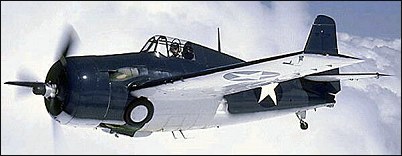 |
Grumman F4F Wildcat1937 |  |
| CARRIER-BORNE FIGHTER-BOMBER | Virtual Aircraft Museum / USA / Grumman |
 |
In 1931 a very young American aviation manufacturing company - Grumman Aircraft Engineering Corporation - received its first contract from the US Navy for a carrier-based fighter of biplane configuration. Under the designation FF (fighter) or SF (scout), they marked the beginning of an association which seems certain of remaining unbroken for at least a half-century. In that period some remarkable naval aircraft have originated from Grumman, earning the trust and respect of those who have flown them in peace and war. The company's first carrier-based fighter of monoplane configuration was designed to meet a US Navy requirement which originated in 1935, but it was not until July 1936 that the Navy ordered this aircraft, under the designation XF4F-2. In its developed service form it was to prove an outstanding naval fighter of World War II, but when first evaluated against a competing design from the Brewster Aeronautical Corporation, it failed to be selected for production, despite being some 16km/h faster than the Brewster design. To overcome the shortcomings of the XF4F-2, a new prototype was built with a more powerful two-stage supercharged engine, and airframe revisions which increased wing span and brought changes to wingtips and tail surfaces. In this form the XF4F-3 flew for the first time on 12 February 1939. The Wildcat was first ordered by the US Navy in 1939 and the F4F-3, F4F-4 and F4F-7 (a special long-range photographic-reconnaissance version of the F4F-4) were all built by the Grumman company. Concurrently the British Martlet (later renamed Wildcat) Mk I to IV were Grumman-built. In 1942 the manufacture of the Wildcat was transferred to the Eastern Aircraft Division of the General Motors Corporation. The first FM-1 Wildcat, assembled from parts supplied by Grumman, flew on 1 September 1942. By 11 April 1944 the Eastern Aircraft Division had produced its 2,500th Wildcat. The FM-1, fitted with a Pratt & Whitney R-1830-86 engine, was virtually the same as the F4F-4 (Wildcat IV). The FM-2 (Wildcat VI), which went into production in 1943, was fitted with a Wright R-1820-56 engine of greater power but lower weight than the previous unit, had a redesigned tail unit with a taller fin and rudder and had the oil coolers removed from the under surface of the centre-section to the cowling, which was revised in shape. The removal of the oil coolers permitted the installation of universal racks under the inner wings for bombs or auxiliary fuel tanks. Altogether nearly 8,000 Wildcats were built, three-quarters by the Eastern Division. These were used operationally by the US Navy on a wide scale in the Pacific (FM-2 in particular serving as light escort carrier fighters), participating in the battles of the Coral Sea and Midway, and were used extensively in the attack on Guadalcanal. Although somewhat inferior to the Japanese Zero, the rugged Wildcat proved invaluable in the early stages of the war in the Pacific, until gradually replaced by more effective fighters from 1943, although the type remained in first-line service until the end of the war. British Martlets initially replaced Sea Gladiators and, like their US Navy counterparts, remained operational until the end of the war.

|  COMPANY PROFILE | |||||||||||||||||||||||||||||||||||||||||||||||||||||||||||||||
 |

|

